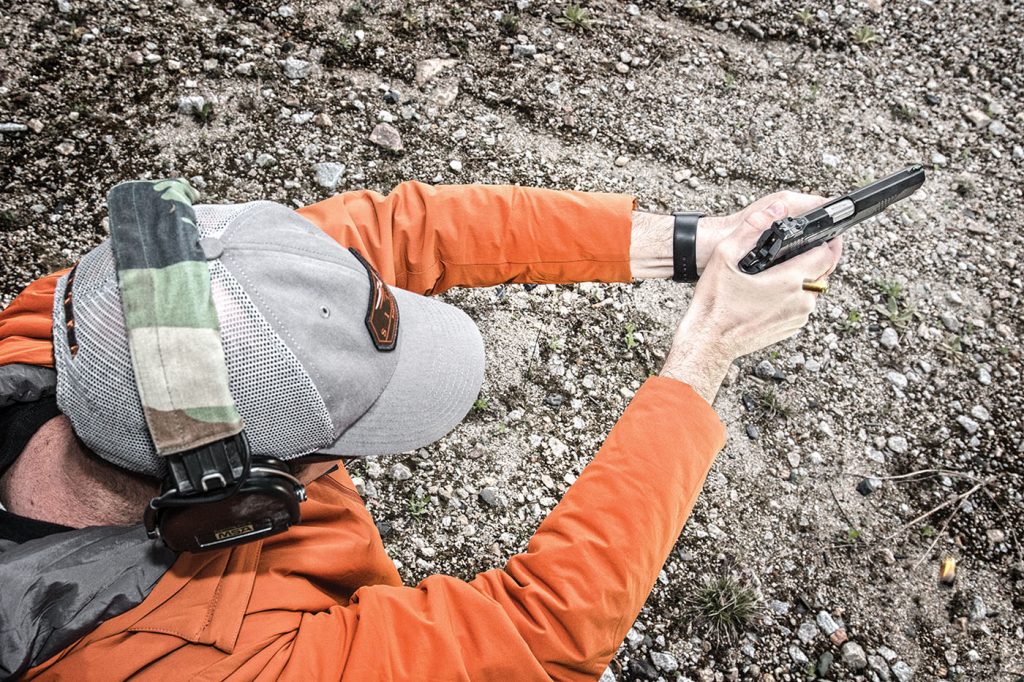Accuracy
I tested Wilson Combat X9L at 25 yards from a Matrix rest on a concrete bench, measuring each five-shot group once overall and again for the best three, having long since learned that the second measurement factors out unnoticed human error and generally approximates what the same load will do for all five from a machine rest.
The 124-grain selection was SIG’s V-Crown jacketed hollow point. Its five-shot group ran 2.55”, due largely I suspect to unnoticed shooter error, because four of them went into barely more than half that, 1.30”. The best three? One inch on the nose.

The 115-grain was Federal’s 9BPLE jacketed hollow point, rated for 1300 foot-seconds velocity from a five-inch barrel such as this one. From the Illinois State Police to the DeKalb County Sheriff’s Office back in the day, this “old school” JHP earned an enviable reputation for “stopping power” in its caliber. The test X9L put five of these bullets into 1.65”, with the best three under an inch – 0.95”, to be exact.
Winchester’s 147 grain subsonic 9mm ammo line began in the 1980s with their OSM, or Olin Super Match JHP, and has been famous for accuracy ever since. Our test load was a practice round, Winchester’s 147 grain brass enclosed base, and it lived up to its family reputation with the best group of the test: five shots in an inch and a quarter, the best three in exactly one half of one inch.
Clearly, this latest X9 is an accurate pistol. Point of aim/point of impact coordinates showed it had left the factory sighted for a six-o’clock hold, with the 147-grain subsonic (as usual) grouping a little higher than the lighter, faster rounds.
Shooting the X9L
All of us at the writers’ seminar were turned loose with an array of these pistols and a few thousand rounds of ammo on Bill Wilson’s private (and expansive) steel range in Arkansas. We were hitting steel rifle plates regularly with them at a hundred yards, which sort of predicted the excellent results I would later get from On Target’s test sample on the bench rest. Everyone seemed very happy with the trigger pull. Dimensions were good: from the five-foot female who participated to the six-foot-plus guys with bear paws, the dimensions of the EDC X9L were “right.”

With a 1911-ish pistol of this size and weight, recoil with 9mm ammo was predictably a non-issue, and recovery in rapid fire was extremely fast. With increasingly arthritic hands, this writer found the magazine release easier than on the standard slim-grip 1911 frame, and the magazine well on the new model practically sucked the reload mag into the pistol. Those who closed the slide with the slide lock lever found it shaped to be very fast and absolutely positive, while I saw no fumbles among those who preferred to perform this final element of the reload with a slide tug. Bill Wilson, you must remember, was a many time national champion in action shooting when he had time to compete, and was once the captain of the United States Team in the World Championships of the International Practical Shooting Confederation. Bill made his reputation with the 1911 pistol; he made the company by crafting better 1911s, first as a custom pistolsmith and later as a premium manufacturer; and he knows exactly how to make them run better.
Reliability

I’ve had two EDC X9s in the past for extensive testing, and both worked 100% for a total round count well into four figures. Every pistol that leaves the Wilson Combat factory has a total of 71 rounds put through it in function and accuracy testing, which has to be an industry high water mark. That said, at the writer’s seminar, there were a few feedway stoppages with the 18-round magazines. Bill Wilson was there when it happened, and as you might imagine he and his engineers got on top of it the next morning. He explained to me shortly thereafter, “We traced the problem to dry, dirty and worn out mag springs. We had been doing long term reliability testing with these guns, then an extensive video shoot with them and apparently no one thought it would be a good idea to clean and lube them or change the recoil springs which had close to 5,000 rounds on them!!!”
Carrying the EDC X9L

Note that the EDC (Every Day Carry) appellation remains on this larger X9. I wore it for a full day of coaching and shooting in a Ky-Tac Kydex holster crafted for a standard five-inch 1911. Fast draw, decent concealability, and no discomfort. I would not be putting the “grippy” stippled grip-frame against bare skin under an untucked shirt, however; that’s what undershirts are for.
Bottom Line
The malfs seen in early testing appear to have been cleared up, allowing buyers of production five-inch EDC X9s to enjoy the same reliability that has made the original four-inch model so hugely popular among the serious shooters. Overall, this Wilson Combat pistol exhibits excellent accuracy, shootability, and build quality that make it worth its $2995 MSRP. See the EDC X9 line at your nearest dealer, or for more information, contact Wilson Combat; Tel.: (800) 955-4856; Web: www.wilsoncombat.com




















